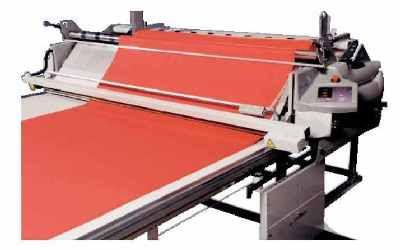Fabric Spreading:
This is a preparatory operation for cutting and consists of laying plies of cloth one on top of the other in a predetermined direction and relationship between the right and wrong sides of the cloth. The composition of each spread i.e. the number of plies of each color is obtained from the cut order plan. Number of plies depends on:
 |
| Fabric spreading |
1. Capacity of the cutting machine
2. Volume of production
3. Type of fabric itself (rough or slippery)
4. Thickness of fabric
Types of Fabric Spreading:
2. Volume of production
3. Type of fabric itself (rough or slippery)
4. Thickness of fabric
Types of Fabric Spreading:
The spreads can be of two basic types:
1. Flat spreads- all plies are of the same length.
2. Stepped spreads- this as the name suggests, is built up in steps, with all the plies in one step having the same length. A stepped spread is generally used when the quantities to be cut precludes the use of a flat spread. The cut order plan details the colors and ply lengths for a stepped spread, if it is needed.
Requirements of Spreading Process:
1. Alignment of plies in both length and width direction- length and width of fabric must be at least equal to marker length and width.
2. Elimination of fabric defects/flaws- any faults identified on the incoming fabrics will be tagged and will be avoided.
3. Correct ply direction (especially for asymmetrically printed fabrics)- all faces up, all faces down, face to face etc.
4. Correct ply tension- ply tension must be uniform and as much less as possible.
5. Avoidance of distortion in the spread during cutting- polythene sheets are used under the bottom ply to resist friction of the bottom ply with the base plate of the knife.
6. Fabrics must be flat and free from any crinkle & crease- these cause defect in garments due to variation in dimension.
7. Checks and stripes- should be matched.
Automatic Programmable Spreading Machines:
All the requirements of spreading process can be fulfilled by fully automatic spreading machines. Their features include:
- Automatic loading/unloading and threading/rewinding device for fabric rolls.
- Automatic roll turning arrangement for face to back lay.
- Automatic leveling device for fabric edge alignment.
- Automatic cutting device (one way or two way cutoff) at the end of a run.
- Automatic tensioning device to control fabric tension.
- Automatic lay height sensing elevator.
- Programmable lay length, ply height and step-laying.
- Spreading seeds up to 140 m/min.



 06:42
06:42
 vishnu
vishnu

 Posted in:
Posted in: 






.jpg)

0 comments:
Post a Comment